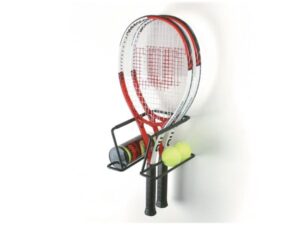How Long Tennis Strings Last
The lifespan of tennis strings can vary based on several factors, including the type of string, playing frequency, playing style, and the player’s level of play. On average, tennis strings can last anywhere from 3 to 7 weeks and a few weeks to a few months before they start losing their tension and performance characteristics. Here are some factors that can influence the lifespan of tennis strings:
- String Material: Different types of string materials, such as natural gut, synthetic gut, polyester, and multifilament, have varying levels of durability. For example, polyester strings tend to be more durable but can lose tension faster, while natural gut strings offer excellent playability but may not last as long. Discover about How To String a Tennis Racket
- Playing Frequency: The more frequently you play, the faster your strings will wear out. Regular players who hit the courts multiple times a week might need to restring their racket more often compared to occasional players.
- Playing Style: Aggressive players who generate a lot of spin and power tend to put more stress on their strings, causing them to wear out faster. Players with a more controlled and consistent playing style may get slightly more mileage out of their strings.
- String Tension: Higher string tension can lead to increased string breakage, but it can also cause the strings to lose tension faster. Lower tension might provide more longevity but could impact performance.
- Court Surface: The type of court you play on can affect how quickly your strings wear down. Hard courts tend to be more abrasive and can cause strings to fray more quickly than clay or grass courts.
- Environmental Factors: Extreme temperatures, humidity, and exposure to sunlight can also impact the lifespan of tennis strings.
- Player’s Level: Professional players often restring their rackets more frequently to maintain optimal performance, while recreational players might not feel the need to restring as often.
Also read the Article: How Much Does a Tennis Racket Restring Cost
As a general guideline, many players, both recreational and competitive, restring their rackets every 20 to 30 hours of play. However, this can vary widely based on the factors mentioned above. It’s recommended to monitor the tension and overall condition of your strings regularly. If you notice a significant decrease in playability, control, or tension, it’s likely time to consider restringing your racket. Always consult with your local tennis shop or a racket technician for personalized advice based on your playing habits and preferences.
Understanding Tennis Strings
Types of Tennis Strings
There are various types of tennis strings available in the market, including natural gut, synthetic gut, multifilament, and polyester. Each type has its unique characteristics and durability.
Natural Gut Strings
Natural gut strings, made from cow or sheep intestines, are known for their exceptional feel and playability. However, they tend to be the least durable among the string types.
Synthetic Gut Strings
Synthetic gut strings are designed to mimic the playability of natural gut strings while offering better durability. They are a popular choice among recreational players.
Multifilament Strings
Multifilament strings provide a good balance between playability and durability. They are constructed using multiple fibers, making them softer on the arm compared to other options.
Polyester Strings
Polyester strings are highly durable and offer excellent control. However, they are stiffer and can lead to more strain on the arm if not properly strung.
Factors Affecting String Longevity
Playing Frequency
The more frequently you play, the faster your tennis strings will wear out. Regular players may need to restring their rackets more often compared to occasional players.

Playing Style
Aggressive players who generate a lot of spin and power tend to put more stress on their strings, causing them to break down faster.
Type of Strings
As mentioned earlier, the type of strings you use directly affects their lifespan. Natural gut strings tend to have the shortest lifespan, while polyester strings last longer.
String Tension
String tension can impact both playability and durability. Higher string tension provides better control but may lead to quicker string breakage.
Environmental Factors
Exposure to extreme temperatures, humidity, and UV rays can accelerate the deterioration of tennis strings.
Signs of Worn-Out Strings
Loss of Tension
When your strings start to lose tension, you’ll notice a decrease in control and power in your shots.

Reduced Playability
Worn-out strings can result in a harsher feel and less responsive shots.
Visible Wear and Fraying
Inspect your strings regularly for signs of fraying, notching, or visible wear along the hitting surface.
Extending the Lifespan of Tennis Strings
Regular Maintenance
Clean your strings after each match to remove dirt and sweat, which can contribute to faster string deterioration.
String Savers
String savers, small plastic or silicone pieces placed between the strings, can reduce friction and extend string life.
Proper Stringing
Having your racket professionally strung at the right tension can significantly impact the longevity of your strings.
Rotate Rackets
If you have multiple rackets, rotate them during matches to distribute the wear and tear among different sets of strings.
Conclusion
In the world of tennis, the lifespan of your strings can greatly affect your overall performance. Understanding the factors that influence string longevity and adopting proper maintenance techniques can help you get the most out of your equipment. Whether you’re a recreational player or a seasoned pro, keeping your tennis strings in optimal condition ensures that you’ll be able to serve up your best shots on the court.
FAQs
Q: How often should I restring my tennis racket?
A. The frequency of restringing depends on factors such as your playing frequency and style. On average, professional players restring their rackets every few matches, while recreational players may do so a few times a year.
Q: Can I restring my tennis racket myself?
A. While it’s possible to restring your racket at home, it’s recommended to have it done by a professional to ensure proper tension and string alignment.
Q: Are natural gut strings worth the shorter lifespan?
A. Natural gut strings offer unparalleled playability, making them a popular choice among competitive players despite their shorter lifespan.
Q: Can string savers really extend the life of my strings?
A. Yes, string savers can help reduce friction between strings, potentially extending their lifespan.
Q: Should I always use the maximum recommended string tension?
A. Not necessarily. The recommended tension range printed on your racket is a guideline. Experiment with different tensions to find the one that suits your playing style and comfort level best.











